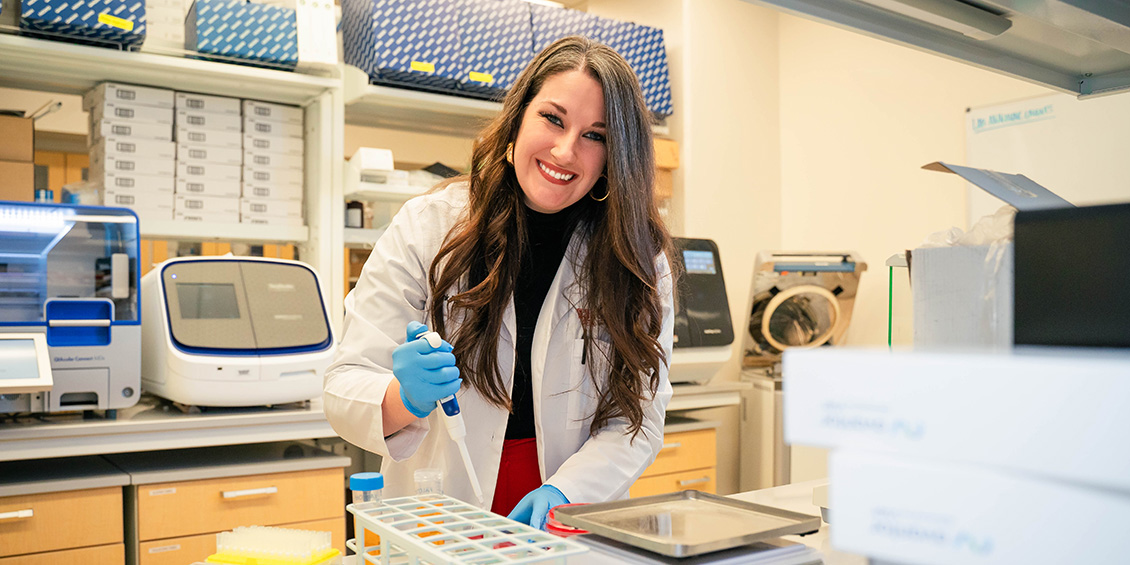Faculty News
UHCOP Researcher Eubank Honored for Groundbreaking Study on Antibiotic Resistance in Deadly Gut Infection
Nov. 19 — University of Houston College of Pharmacy Research Assistant Professor Taryn Eubank, Pharm.D., BCIDP, has been recognized by the American Society of Health-System Pharmacists (ASHP) Foundation with the prestigious Drug Therapy Research Award, which honors exceptional original research published in peer-reviewed biomedical journals that advances understanding of medication use, efficacy, and safety. Eubank’s award-winning study explored how reduced vancomycin susceptibility in Clostridioides difficile (C. diff) may impact patient outcomes, specifically the sustained clinical response (SCR) following treatment. The research provides critical insights into one of the most urgent antimicrobial resistance threats in the United States.
C. diff is the leading cause of health care-associated infections, responsible for nearly 500,000 cases and tens of thousands of deaths annually. While oral vancomycin has long been a cornerstone of treatment due to its greater accessibility than other antibiotics such as fidaxomicin, cure rates have dropped from nearly 100% in the early 2000s to around 70% in recent years. The cause of this decline remains unclear, prompting Eubank and her team to investigate whether increased vancomycin use—like the recent 54% uptick following updated treatment recommendations published in 2018—may be contributing to reduced susceptibility to vancomycin.
Using bacterial samples, known as isolates, from 300 patients treated only with vancomycin, Eubank and team found that patients infected with strains showing reduced vancomycin susceptibility were significantly less likely (76%) to achieve the primary outcome of 30-day SCR (symptom-free with no recurrence or death within 30 days) than those infected with susceptible strains (86%). Lower initial cure rates at 14 days were also observed. About 25% of patients treated with vancomycin for C. diff. got sick again. In over 80% of those recurrences, the infection was caused by the same bacterial strain that caused the original illness and not a new infection. Because the same strain survives treatment and causes relapses, it’s reasonable to suspect the drug may not fully eliminate the bacteria.
The study also examined the role of a genetic mutation, Thr115Ala, in the VanR regulatory protein, part of a two-component regulatory system (VanR/VanS) that controls vancomycin resistance in bacteria. When VanR is activated, it triggers enzymes that produce a cell wall to which vancomycin can no longer bind. While this mutation was associated with higher vancomycin resistance levels, it appeared most frequently in the hypervirulent RT 027 strain, making it difficult to determine whether the mutation itself, or other virulent traits of RT 027, were responsible for poorer outcomes. RT 027 was also linked to more severe or fulminant disease (62%) compared to other types (45%). Approximately 43% of patients died within 30 days of diagnosis, with most deaths occurring in the first 12 days.
Eubank’s research underscores the growing importance of understanding antibiotic resistance mechanisms, such as the activation of the hidden vanG operon, which can alter bacterial cell wall targets and reduce vancomycin binding effectiveness. Since many C. diff infections recur after vancomycin treatment, often from the same bacterial strain, it’s plausible that reduced susceptibility plays a key role in treatment failure and relapse. Eubank’s findings highlight the urgent need for expanded testing and surveillance to detect reduced susceptibility in clinical isolates.
Eubank’s research project was the basis for the acquisition of her National Institute of Allergy and Infectious Diseases (NIAID) T32 fellowship funding. Her mentors include Robert L. Boblitt Endowed Professor of Drug Discovery Kevin Garey, Pharm.D., FASHP, FIDSA, FCCP, BCIDP, and Julian Hurdle, Ph.D., professor at Texas A&M University (TAMU) and director of the Center for Infectious and Inflammatory Diseases. Co-author and collaborator on this project was Chetna Dureja, Ph.D., molecular microbiologist and postdoctoral research associate at TAMU.
— Kristin Marie Mitchener
